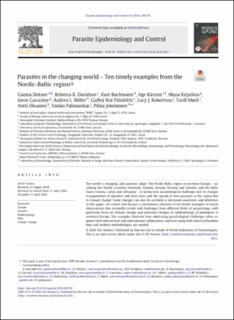| dc.contributor.author | Gunita, Deksne | |
| dc.contributor.author | Davidson, Rebecca K. | |
| dc.contributor.author | Kurt, Buchmann | |
| dc.contributor.author | Age, Karssin | |
| dc.contributor.author | Muza, Kirjusina | |
| dc.contributor.author | Inese, Gavarane | |
| dc.contributor.author | Miller, Andrea L. | |
| dc.contributor.author | Gudny Rut, Palsdottir | |
| dc.contributor.author | Robertson, Lucy | |
| dc.contributor.author | Mørk, Torill | |
| dc.contributor.author | Antti, Oksanen | |
| dc.contributor.author | Vaidas, Palinauskas | |
| dc.contributor.author | Pikka, Jokelainen | |
| dc.date.accessioned | 2021-03-29T08:38:08Z | |
| dc.date.available | 2021-03-29T08:38:08Z | |
| dc.date.created | 2020-05-14T16:30:08Z | |
| dc.date.issued | 2020 | |
| dc.identifier.issn | 2405-6731 | |
| dc.identifier.uri | https://hdl.handle.net/11250/2735868 | |
| dc.description.abstract | The world is changing, and parasites adapt. The Nordic-Baltic region in northern Europe – including the Nordic countries Denmark, Finland, Iceland, Norway and Sweden, and the Baltic States Estonia, Latvia and Lithuania – is facing new parasitological challenges due to changes in populations of parasites and their hosts and the spread of new parasites to the region due to climate change. Some changes can also be ascribed to increased awareness and detection. In this paper, we review and discuss a convenience selection of ten timely examples of recent observations that exemplify trends and challenges from different fields of parasitology, with particular focus on climate change and potential changes in epidemiology of pathogens in northern Europe. The examples illustrate how addressing parasitological challenges often requires both intersectoral and international collaboration, and how using both historical baseline data and modern methodologies are needed. | en_US |
| dc.language.iso | eng | en_US |
| dc.rights | Attribution-NonCommercial-NoDerivatives 4.0 Internasjonal | * |
| dc.rights.uri | http://creativecommons.org/licenses/by-nc-nd/4.0/deed.no | * |
| dc.title | Parasites in the changing world – Ten timely examples from the Nordic-Baltic region | en_US |
| dc.type | Peer reviewed | en_US |
| dc.type | Journal article | en_US |
| dc.description.version | publishedVersion | en_US |
| dc.subject.nsi | VDP::Basale biofag: 470 | en_US |
| dc.subject.nsi | VDP::Basic biosciences: 470 | en_US |
| dc.subject.nsi | VDP::Basale biofag: 470 | en_US |
| dc.subject.nsi | VDP::Basic biosciences: 470 | en_US |
| dc.source.volume | 10 | en_US |
| dc.source.journal | Parasite Epidemiology and Control | en_US |
| dc.identifier.doi | https://doi.org/10.1016/j.parepi.2020.e00150 | |
| dc.identifier.cristin | 1811103 | |
| dc.source.articlenumber | e00150 | en_US |
| cristin.ispublished | false | |
| cristin.fulltext | original | |
| cristin.qualitycode | 1 | |

